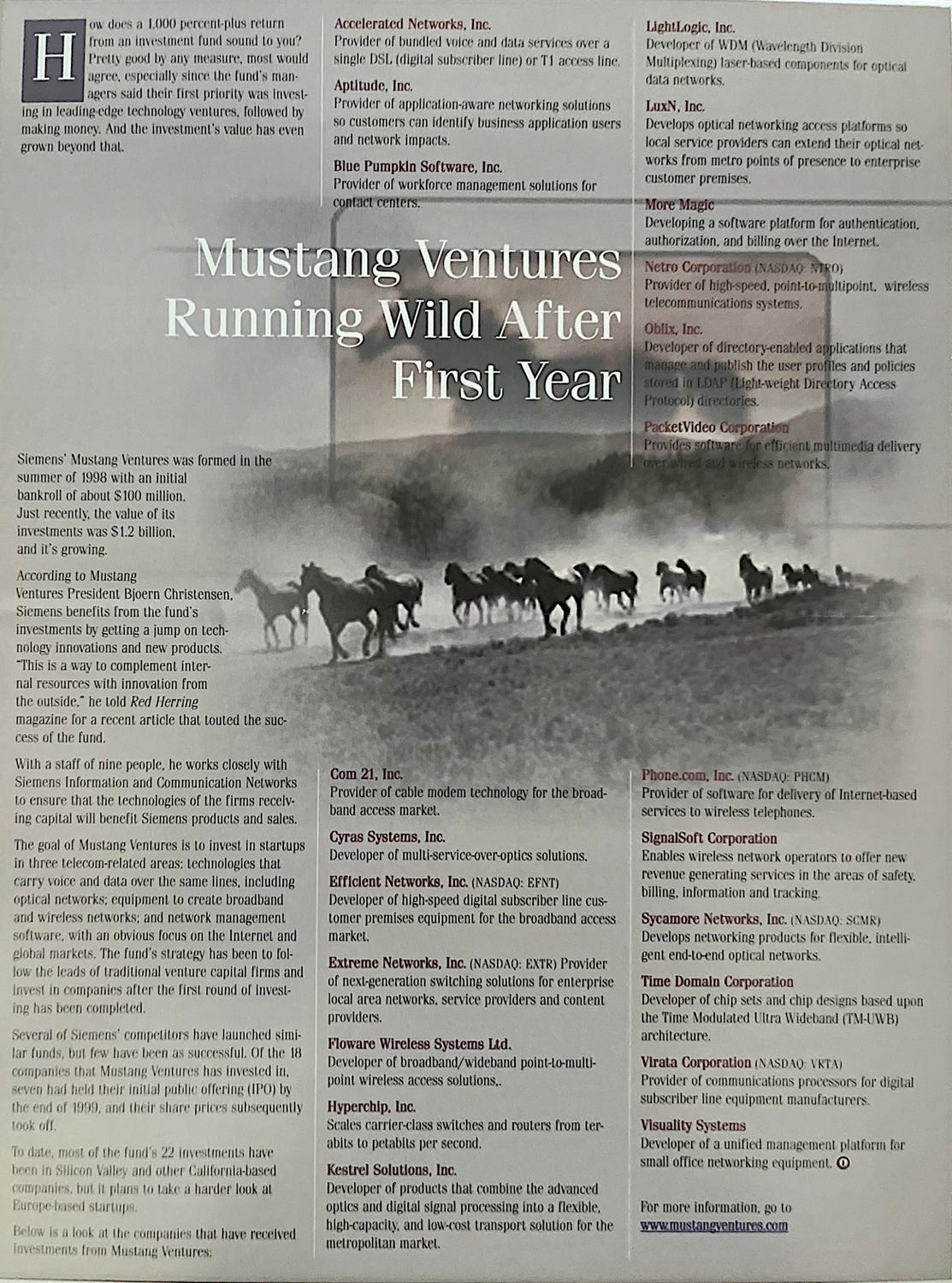#16: Mustang Ventures - The first Siemens CVC entity
Hi, I'm Jeppe and welcome to my weekly newsletter on Corporate Venturing, released every Tuesday. My aim is to provide a comprehensive perspective on the latest developments in the field and its related topics, drawing from the insights of top management, venture capitalists, founders, LPs, and family offices. I aim to offer valuable information and thought-provoking content that will aid in understanding the importance of Corporate Venturing in business strategy.
Today's newsletter tells the story of one of the pioneers of Corporate Venture Capital, Bjoern Christensen, and highlights the valuable insights he gained from the very early days of CVC.
How I got connected with Bjoern:
In early 2023, I was introduced to Jukka Pertola through a friend and former colleague of mine, Jorgen Smidt. I had a great discussion with Jukka, who shared his experiences as the CEO of Siemens Denmark and as Chairman of Siemens Gamesa. During our conversation, Jukka mentioned a Danish individual who used to work for Siemens and led their early CVC efforts, which immediately sparked my interest. The name of this Dane is Bjoern Christensen.
A couple of months ago, I connected with Bjoern, who is currently primarily involved in VGI/V2X (Vehicle Grid Integration / Vehicle to Everything). We had a great conversation, and Bjoern graciously agreed to share his insights from his time at Siemens Venture Capital, formerly known as Mustang Ventures.
Last week, I had the opportunity to interview Bjoern about his experience as the Managing Director of Siemens' Venture unit from 1997 until 2005.
How did Siemens Venture Capital start?
It all began with a significant event—the fall of the Berlin Wall on November 9, 1989. Approximately EUR 60 billion was provided by the Federal Government for private German firms to upgrade East Germany telecom grid to West German technology standards. Siemens was allocated a portion of these funds to upgrade the East German Grid and infrastructure.
Now, one might wonder how this connects to Siemens Ventures. Well, Bjoern was working in the Information & Communication Network Division, leading their business development efforts, and this marked the inception of Siemens Ventures. Bjoern collaborated with numerous smaller companies, rapidly making contracts to get access to innovative communication products that Siemens did not have in their portfolio. As activities and corporate culture needed to align, a large consulting firm was brought in to help establish a new structure. This allowed for an “Open Innovation” framework to be established that could be scaled with speed and precision.
The new setup
As part of the established structure, it was agreed that the newly formed setup would be field tested over the next 12 months. Bjoern was assigned the role of a scout and sent to Silicon Valley. However, after just two months, he contacted Siemens and expressed the need for a change in the structure. Bjoern faced difficulties in generating interest from the startups and venture capitalists in the ecosystem. They were reluctant to engage in dialogue with him since he didn't have the authority to invest as a scout.
You need to be an active investor to be recognized as an integral part of the ecosystem
The new strategy proposed by Bjoern was for him to become a 'data collector' with the option to acquire smaller stakes in startups. He aimed to co-invest with top investors and focus on business models and tools within Siemens' area of interest.
The team's first investment was made in 'Efficient Networks,' a company that utilized DSL technology for broadband Internet access. In their initial investment, Siemens acquired a 5% stake in the company. The startup aligned perfectly with Siemens' strategy, offering a product that complemented Siemens’ solutions and could attract new customers to Siemens, particularly in a market that was not yet significant. The success of the initial investment led to a subsequent investment round, increasing Siemens' ownership stake. Siemens eventually acquired Efficient Networks for $1.5 billion.
The birth of Mustang Ventures
The initial phase was a success for Siemens, and it was decided to establish their permanent Corporate Venture Capital (CVC) unit. Bjoern advocated for segregation from the Siemens headquarters as an independent legal unit and managed to achieve it, greatly benefiting Siemens. During that time, the only major corporate investors in the market were Intel Capital and GE Capital. While there weren't many learnings from the market, a considerable number of sound decisions were made regarding decision-making and strategic knowledge sharing. However, to truly distinguish themselves from Siemens since some startups and VCs were afraid to “sleep with an elephant” since they might get squeezed, they needed a new entity name.
At a meeting in Munich, the name Mustang Ventures was chosen. A mustang represents strength, speed, sensitivity, freedom, and a wild nature that symbolizes the Wild West - precisely the qualities needed to be taken seriously by the ecosystem. Thus, the first independent Corporate Venture Capital (CVC) unit of Siemens was born.
The strategic gain
More investments followed, utilizing the established structure. It became easier to leverage the strategic insights and value from Siemens. Bjoern's team prioritized networking and investing alongside top Venture Capital funds, bankers, lawyers, and other experts. They knew how to leverage the collected datapoints and capitalize on them.
One notable success was the investment in Com21, an early pioneer in developing cable modem networks for fast Internet access. Another was Phone.com with technology that allowed Internet access from a mobile device. Mustang Ventures was able to complement the investments with additional technology companies and harness synergies from the Siemens infrastructure, all at the same time.
All in all, Mustang Ventures had 7 IPOs during this time. Like many established companies, Siemens also prioritized risk reduction. Therefore, Mustang Ventures focused on pursuing exits whenever possible during its initial years. Consequently, when the tech bubble burst, Mustang Ventures had already realized a sizeable portion of its portfolio. However, it also experienced write-downs like the rest of the industry. Reflecting on this, Bjoern recommends that all CVCs ensure a combination of financial and strategic returns. If financial returns are not generated, the CVC entity may not survive through crises.
“Financial returns are essential to the survival of corporate venture entities”
Postmortem following 9/1 - 2001
The next major upheaval arrived with the dotcom bust, followed by the horrific events of 9/11. The world was thrown into a deep freeze. The Mustang team took a pause from their activities to conduct a thorough post-mortem analysis of their progress thus far. Siemens had established several incubators and venture units, and it was necessary to streamline operations. Bjoern was entrusted with consolidating everything into Siemens Venture Capital. Most of the incubators were shut down, and a new entity, like Phoenix raising from the ashes, emerged with a fresh focus on all Siemens business areas. The geographical scope was also expanded, and additionally a Fund of Funds was established, allowing Siemens to invest in external VCs and gain insights into technological developments in various regions. Bjoern led all these initiatives until 2005. The CVC achieved a break-even point after the dotcom downturn, and at that juncture, Bjoern made the decision to depart, having successfully created one of the most successful CVCs. He left behind a team of 42 investment professionals, which, given its size, required more management and leadership focus from him, rather than direct involvement and interactions with innovative startups.
Why did Siemens ventures become the success it still is today?
The success ultimately boils down to the quality of the people and the organizational culture. Without the support Bjoern received from senior Siemens management, the venture entity would not have achieved such remarkable results. Initially, the employees were sourced exclusively from Siemens, and the entity was highly successful in attracting top talent from within Siemens. The arrangement was that these employees would work in the venture entity for a year. The truly remarkable aspect was that all employees remained connected to the happenings of the parent company. Furthermore, external hires were brought in to enhance the overall knowledge base. This collaborative approach played a significant role in Siemens' success
“It’s a great advantage for the mother company and a necessity for the corporate to have an Open Innovation concept to avoid being disrupted”
Human resources play an increasingly integral role in the success of the venture unit. Nowadays, it is crucial for companies to focus on what they can offer to their employees. The positive aspect is that employees are becoming more curious about emerging technologies and how existing technologies can be utilized to digitize and address today's challenges.
Knowledge sharing within
Siemens Corporate research (450,000 FTE business) was utilized to extract insights from the Siemens corporate strategy for use within the venture investment. The venture entity had the ability to consult various business units on an ad hoc basis, with one representative from each business unit attached to the entity.
Mustang Ventures' senior management extensively networked within the ecosystem through event sponsorships, conferences, and, of course, their investments. This enabled Mustang Ventures to become a crucial sparring partner for the Siemens C-suite during their visits from Germany. They provided introductions to emerging technologies, connected them with lawyers and bankers in the valley, and introduced them to investors within the ecosystem who were the pioneers of future trends
A last reflection
Looking back, the essence is that innovation is ubiquitous. Every sector is susceptible to rapid disruption. To thrive in today's market, corporations must embrace open innovation. It is no longer feasible to rely solely on internal capabilities. Companies needs to find a way to make risk their ally. If you don’t it will become your mortal enemy.
“Make risk your friend or it will become your immortal enemy”
It is also important to view corporate venture from a portfolio perspective. If the venture entity is solely evaluated based on individual companies, it may face closure. Remember to allow sufficient time for the investments to mature and always keep an eye on financial returns.
I hope you enjoyed this week's newsletter. If you have any suggestions or contributions that you would like to share with me, please do not hesitate to reach out. I would be delighted to hear from you.




